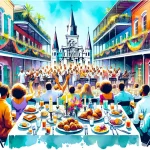A historic gem, Tremé Lafitte proudly upholds New Orleans’ African-American and Creole cultural legacies. This neighborhood, often regarded as the oldest African-American community in the United States, has shaped the city’s cultural landscape for over two centuries.
In This Article
TL;DR
- Tremé Lafitte’s pivotal role in nurturing African-American and Creole traditions in New Orleans.
- The neighborhood’s significance in the birth and evolution of jazz music.
- Highlights of ongoing cultural events, institutions, and landmarks that define Tremé Lafitte.
Historical Significance of Tremé Lafitte
Originating in the late 18th century as part of a plantation, Tremé Lafitte became home to a diverse population of free people of color and European immigrants after the land was subdivided in 1810. Throughout the 19th century, this area thrived as a hub for African-American and Creole communities, fostering a unique blend of cultural traditions that would shape New Orleans‘ identity for generations.
Congo Square, a gathering place where enslaved Africans and free people of color would congregate on Sundays to play music, dance, and sell goods, is one of Tremé Lafitte’s most significant historical landmarks. This tradition, dating back to the early 1800s, played a crucial role in the development of African-American music and laid the foundation for the birth of jazz.
Cultural Institutions and Landmarks
Backstreet Cultural Museum
The Backstreet Cultural Museum, located on St. Claude Avenue, is dedicated to showcasing the contributions of African-Americans to New Orleans’ culture. The museum features exhibits on Mardi Gras Indians, second line parades, jazz funerals, and other unique traditions associated with the city.
St. Augustine Church
St. Augustine Church, founded in 1841 and considered the oldest African-American Catholic parish in the United States, has been a pillar of the community for over 180 years. The Tomb of the Unknown Slave on the church grounds serves as a powerful reminder of the neighborhood’s history and struggles.
Louis Armstrong Park
Louis Armstrong Park, named after the legendary jazz musician who grew up in the area, is a 32-acre cultural hub featuring sculptures of iconic figures, the Mahalia Jackson Theater for the Performing Arts, and various events throughout the year.
Music and Performing Arts
Tremé Lafitte’s influence on the evolution of jazz and brass band music is undeniable. The neighborhood has been home to countless musicians who have shaped American music, from early pioneers to modern legends like Kermit Ruffins and the Rebirth Brass Band.
Venues like the Candlelight Lounge, where the Tremé Brass Band performs weekly, the Mother-in-Law Lounge, and the Ooh Poo Pah Doo Bar carry on the tradition of live music that has been a staple of the community for over a century.
Visual Arts and Crafts
Tremé Lafitte is also a hub for visual arts, with local artists drawing inspiration from the neighborhood’s rich cultural heritage. The New Orleans African American Museum showcases the work of African-American artists from the 18th century to the present day, exploring themes of identity, history, and social justice.
The neighborhood is known for its unique crafts, particularly the elaborate, hand-sewn Mardi Gras Indian costumes. The Backstreet Cultural Museum houses an extensive collection of these costumes and other artifacts related to the tradition.
Culinary Traditions
Tremé Lafitte is home to some of New Orleans’ most iconic restaurants serving classic Creole dishes for generations.
Dooky Chase’s Restaurant
Dooky Chase’s Restaurant, founded in 1941, is a local institution that has been at the forefront of the civil rights movement and the culinary scene. The restaurant is known for its gumbo, fried chicken, and extensive collection of African-American art.
Willie Mae’s Scotch House
Willie Mae’s Scotch House has been serving up some of the city’s best fried chicken since the 1950s, winning numerous awards, including a James Beard Award in 2005.
Annual Events and Festivals
The Tremé Fall Festival and Tremé Creole Gumbo Festival are popular annual events that showcase the neighborhood’s cultural heritage through live music, food vendors, and arts and crafts booths.
Participating in Tremé Lafitte’s Cultural Life
Visitors can immerse themselves in Tremé Lafitte’s cultural life by exploring the neighborhood on foot or by bike, and participating in tours and educational programs offered by cultural institutions like the Backstreet Cultural Museum. Attending festivals and events respectfully, engaging with locals, and learning about local customs are great ways to appreciate the neighborhood’s rich culture.
Preservation Efforts and Future Outlook
While facing challenges like development pressures and the impact of short-term rentals, organizations like the Preservation Resource Center of New Orleans and the Faubourg Tremé Neighborhood Association work to protect Tremé Lafitte’s cultural and architectural heritage. Despite these challenges, the neighborhood remains a vibrant and resilient community, deeply committed to preserving its African-American and Creole cultural legacy for future generations.






